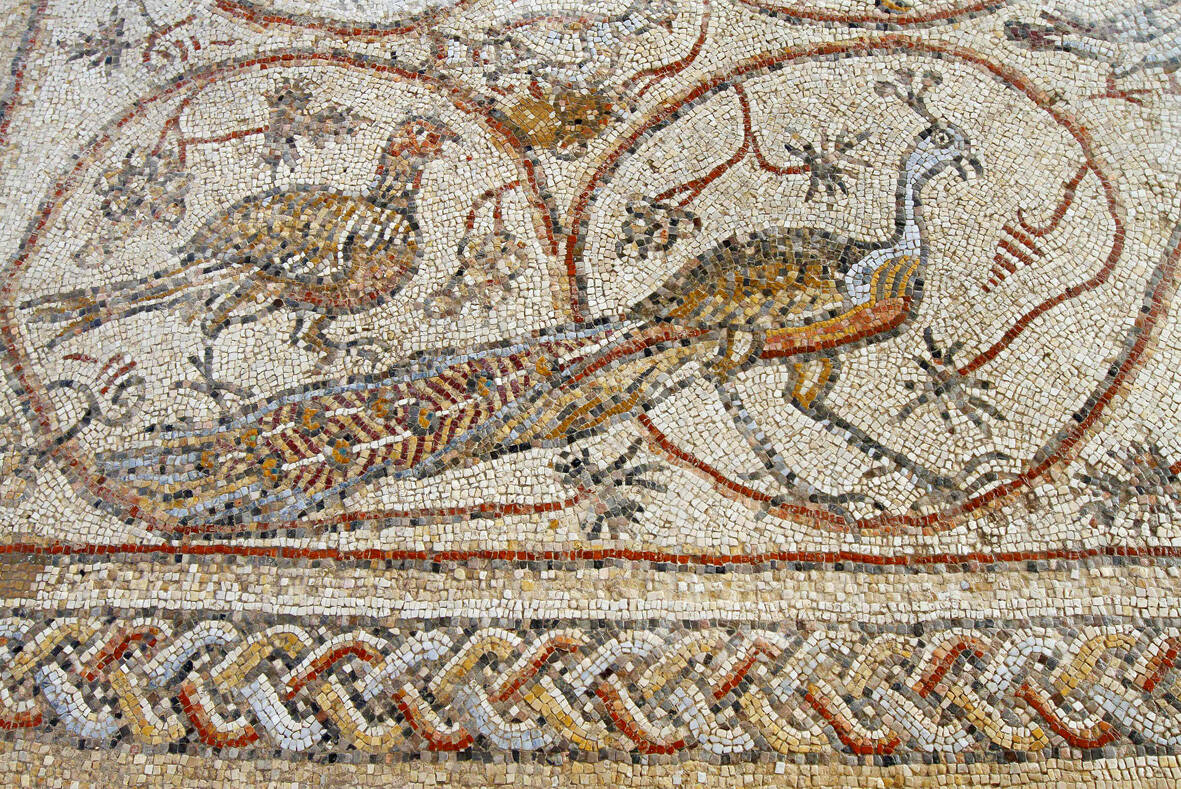Nearly three decades of archaeological finds in Gaza were hurriedly evacuated Thursday from a Gaza City building threatened by an Israeli strike, said an official in charge of the antiquities.
“This was a high-risk operation, carried out in an extremely dangerous context for everyone involved — a real last-minute rescue,” said Olivier Poquillon, director of the French Biblical and Archaeological School of Jerusalem (EBAF), whose storehouse housed the relics.
On Wednesday morning, Israeli authorities ordered EBAF — one of the oldest academic institutions in the region — to evacuate its archaeological storehouse located on the ground floor of a residential tower in Gaza City that was due to be targeted.

Photo: AFP
The Israeli army did not confirm the warning when asked, but several sources said France, UNESCO and the Latin Patriarchate of Jerusalem played a key role in securing a brief reprieve that allowed most of the artifacts to be removed.
“With almost no international actors left on the ground, no infrastructure, nothing functioning, we had to improvise transport, labor and logistics,” said Poquillon.
The evacuation, he added, was carried out in strict secrecy, with “the overriding concern, as a religious organization, of not endangering human lives,” as Israeli military pressed operations in the territory’s largest urban hub.
The depot contained around 180 cubic meters of finds from Gaza’s five main archaeological sites, including the fourth-century Saint Hilarion Monastery, listed as a UNESCO World Heritage site.
All of these sites have been damaged, EBAF said, expressing concern for “unique” mosaics left exposed despite their fragility.
‘ONLY TRACE’
Poquillon said Gaza has “an extremely ancient heritage, very precious for the region, showing the succession and coexistence of peoples, cultures and religions.”
Of Gaza’s two museums, one has been destroyed and the other heavily damaged since the war erupted nearly two years ago.
Researchers said that aside from scattered ruins highly vulnerable to bombardment, the EBAF storehouse was the only significant repository of artifacts left in the Palestinian territory.
The rediscovery of Gaza’s past began in the wake of the 1993 Oslo accords.
Two years later, the newly created Gaza antiquities service opened its first archaeological dig in cooperation with EBAF, unearthing remnants of the ancient Greek port of Anthedon and a Roman necropolis.
Excavations stalled after Hamas seized power in 2007 and Israel imposed a blockade, resuming years later with support from the British Council and French NGO Premiere Urgence Internationale (PUI).
Now, with Israel contemplating a full takeover of Gaza and ceasefire talks stalled, archaeologists say prospects for renewed excavations are remote.
UNESCO, which has already identified damage to 94 heritage sites in Gaza using satellite images, including the 13th-century Pasha’s Palace, has not yet been able to take a full inventory.
“We saved a large part, but in a rescue you always lose things, and you always face painful choices,” said Rene Elter, an archaeologist affiliated with EBAF and scientific coordinator for PUI.
The depot, he said, was especially valuable because collections had been classified systematically.
“Many items have been broken or lost, but they had been photographed or drawn, so the scientific information is preserved,” Elter explained. “Perhaps that will be the only trace that remains of Gaza’s archaeology — in books, publications, libraries.”

Late last month Philippines Foreign Affairs Secretary Theresa Lazaro told the Philippine Senate that the nation has sufficient funds to evacuate the nearly 170,000 Filipino residents in Taiwan, 84 percent of whom are migrant workers, in the event of war. Agencies have been exploring evacuation scenarios since early this year, she said. She also observed that since the Philippines has only limited ships, the government is consulting security agencies for alternatives. Filipinos are a distant third in overall migrant worker population. Indonesia has over 248,000 workers, followed by roughly 240,000 Vietnamese. It should be noted that there are another 170,000

Hannah Liao (廖宸萱) recalls the harassment she experienced on dating apps, an experience that left her frightened and disgusted. “I’ve tried some voice-based dating apps,” the 30-year-old says. “Right away, some guys would say things like, ‘Wanna talk dirty?’ or ‘Wanna suck my d**k?’” she says. Liao’s story is not unique. Ministry of Health and Welfare statistics show a more than 50 percent rise in sexual assault cases related to online encounters over the past five years. In 2023 alone, women comprised 7,698 of the 9,413 reported victims. Faced with a dating landscape that can feel more predatory than promising, many in

“This is one of those rare bits of TikTok fitness advice with a lot of truth behind it,” says Bethan Crouse, performance nutritionist at Loughborough University. “Sometimes it’s taken a bit too literally, though! You see people chugging protein drinks as they’re scanning out of their gym.” Crouse recommends the athletes she works with consume 20-30g of protein within 30-60 minutes of finishing a resistance training session. “The act of exercising our muscles increases the breakdown of muscle proteins,” she says. “In order to restore, or hopefully improve them — and get gains such as increased muscle mass or strength —

“Far from being a rock or island … it turns out that the best metaphor to describe the human body is ‘sponge.’ We’re permeable,” write Rick Smith and Bruce Lourie in their book Slow Death By Rubber Duck: The Secret Danger of Everyday Things. While the permeability of our cells is key to being alive, it also means we absorb more potentially harmful substances than we realize. Studies have found a number of chemical residues in human breast milk, urine and water systems. Many of them are endocrine disruptors, which can interfere with the body’s natural hormones. “They can mimic, block